第三章 第三节(增词法 第3版)
英语翻译课第三单元 增减法

3. Cultural Amplification
…, this hopeful person soared into so pleasing a Cupid…. • 译文:这个很有希望的年轻人就扮成极其讨人喜欢的插着
双翅的爱神丘比特。 • …that the female Boundby, instead of being the Gorgon
• 增词法就是在翻译时按照意义、修辞或句法 上的需要,在原文的基础上添加必要的单词、 词组、分句或完整
• Syntactical Amplification
• Lexical Amplification
• Cultural/ric Amplification
1. Syntactical Amplification
第三单元 增减法
• Amplification means supplying necessary words in our translation on the basis of accurate comprehension of the original. As a matter of principle, a translator is supposed to supply necessary words to make his or her version both accurate in meaning and in keeping with the idiomatic use of the language to be translated into. It is for the purpose of “faithful representation” of the thought of the author that we often resort to “amplification”.
第三讲 增词法、重复法

(五)从修辞和连贯角度考虑增词。 This printer is indeed cheap and fine. Yes, I like Chinese food. Lots of people do these days. Sort of fashion. A scientist constantly tried to defeat his hypotheses, his theories and his conclusion. Nobody has raised his hand so we think everyone agrees with Mr. Zhang. He was week and old.
(六)增加必要的副词。 The bridge is long. The crowds meted away. As he at down and began talking, words poured 词的时态靠动词的形式变化或加助 动词来表达,汉语动词没有词形变化,表达 时态要靠增加特有的时态助词或一般表示 时间的词。 1.对某种时间概念作强调时,汉译时往往 需增加一些词语。 1)The old man had taught the boy to fish, and the boy loved him. 2)I had never thought I’d be happy to find myself considered unimportant. But this time I was.
4. 重复英语中作先行词的名词 英语定语从句常用关系词引导,它一方面 代表定语从句所修饰的那个先行词(名词 或代词),一方面在从句中担任一个成分。 汉语中没有关系词,往往需要重复这个作 先行词的名词。 They have staged demonstration and sit- ins and distributed petitions which inevitably find their way to foreign correspondents posted in Moscow.
翻译的技巧增词法与重复法

Fahrenheit (F): Centigrade(C)=5/9*(F-
32) Fahrenheit=C * 9/5 +32
100℉=5/9*(100-32) ℃= 37.7℃
-
20℉ = ? ℃
3.Suddenly he stopped, …, and cut a wisp of alfalfa. (Para. 4)
要是我们及时知道那件事, 事故本来 是可以防止的。(虚拟语气)
After watching for years, he discovered important phenomena.
观察了数年之后他发现了许多重要现象。 (数)
三、重复译法
重复也属于增词。翻译和写作一样。 本应力 求简练,尽量省略一些可有可无的词;有时为 了明确、强调或生动, 却往往需要将一些关 键性的词加以重复。例如:
A river: a large stream of water that discharges into a larger body of water such as a sea, a lake, or another stream.
4. The pines on top of the mountain above us looked as if the fingers of their long boughs were fondling a white cloud. (Para.18)
3. He became an oil baron---all by himself.
他成为一个石油大王, --- 一个白手起家的 石油大王。 4. This has been our position---but not theirs.
英文翻译技巧之增词法与减词法

英文翻译技巧之增词法与减词法英汉两种语言,由于表达方式不尽相同,翻译时既可能要将词类加以转换,又可能要在词量上加以增减。
增词法与减词法在英汉互译中运用相当广泛,但无论增词还是减词,增减的是词,不是意。
一、增词法所谓增词法,就是在翻译时,为了使译文合乎汉语的习惯和表达规律,为了使意思更加明确,从意义、修辞和句法上需要在译文中适当增添一些虽无其词而有其意的词。
增词译法不是凭空想象,必须增之有道,补之有理。
必要的增词对一个句子起着画龙点睛的作用,准确、通顺和完整地表达原文的内容,避免语义模糊。
例1:Packing together with packaging is designed not only as a form of protection but also a form to facilitate handling, storage, to prevent pilferage and what's more to help promote the sales.译文:包装和包装方法不仅仅是为了保护商品,也是为了便利搬运和库存、防止盗窃,更重要的是,有助于促销。
解析:“protection”此处译作“保护商品”,加了“商品”两字,显然比译作“保护”更好。
1.增加原文中省略的部分英语中有省略现象,译为汉语时往往要根据句法需要补出英文中省略的成分,主要包括回答中的省略、动词的省略及比较句中的省略等;另外,为表示态度、逻辑关系等,也需要加词。
(1)增补回答句中省略的词语1例2:—He doesn’t know, does he?—Yes, he does.译文:——他不知道吧?——不,他知道。
例3:—Did you enjoy your time in Beijing?—Yes, I did.译文:——你在北京过得愉快吗?——是的,我过得很愉快。
(2)增补并列结构中省略的词语例4:On average, the economy performs less well in a president's second term than in his first.That pattern probably does not apply to Mr Obama. Since his first term was so difficult, the next, by rights, ought to be better.译文:一般来说,美国总统第二个任期内的经济不如第一任期。
增补法
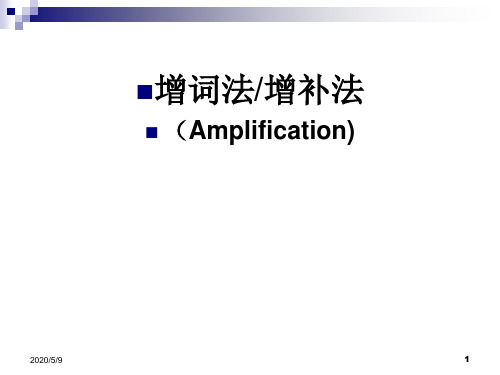
(四)增补冠词 汉译英时往往需要增补必要的冠词 1.耳朵是用来听声音的器官,鼻子是用来嗅气 .耳朵是用来听声音的器官, 舌头用来尝滋味。 味,舌头用来尝滋味。 The ear is the organ which is used for hearing. The nose is used for smelling. The tongue is used for tasting. 2.我们对问题要作全面的分析,才能解决得妥 .我们对问题要作全面的分析, 当。 We must make a comprehensive analysis of a problem before it can be properly solved.
2011-12-31 11
(二)增加概括性词语。汉语里有时不用表明事物范 增加概括性词语。 畴的概括性词语,译成英语时却往往需要增补进去。 畴的概括性词语,译成英语时却往往需要增补进去。 1.要提倡顾全大局。 要提倡顾全大局。 要提倡顾全大局 We should advocate the spirit of taking the whole situation into consideration. 2. 对凭借行业垄断和某些特殊条件获得个人额外收入 必须纠正。( 十五大报告》 。(《 的必须纠正。(《十五大报告》) We must correct the malpractice of individuals obtaining extra incomes by taking advantage of sectoral monopoly and some special privileges. ( 《中国日报》) 中国日报》
6
3.男女老少都参加了战斗。 .男女老少都参加了战斗。 Men and women, old and young, all joined in the battle. 4.他不来我不走。 .他不来我不走。 I shall not go until he comes. 5. 留得青山在,不怕没柴烧。 . 留得青山在,不怕没柴烧。 So long as green hills remain, there will never be a shortage of firewood. 6.送君千里,终有一别。 .送君千里,终有一别。 Although you may escort a guest a thousand miles, yet must the parting come at last.
Unit 3 增词法和减词法
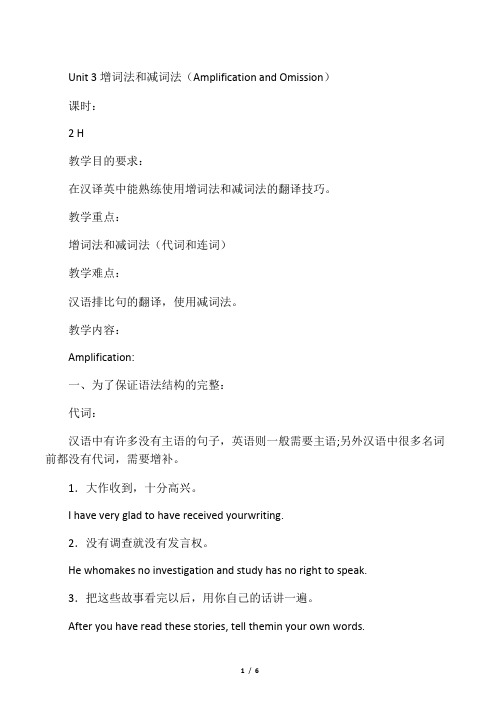
Men and women,old and young in the village,all like shopping in this small supermarket.
4.我妈妈来了,我得回去了。
My mother has arrived, so I have to leave now.
文中暗含的意思:
1.大家都知道xx战场是艰苦些。
Everyone knows that life on the Korean battlefield was rather hard.
2.要提倡xx。
We should advocate the spirit of taking the whole situation into consideration.添加注释性的词语:
汉语中有许多没有主语的句子,英语则一般需要主语;另外汉语中很多名词前都没有代词,需要增补。
1.大作收到,十分高兴。
I have very glad to have received yourwriting.
2.没有调查就没有发言权。
He whomakes no investigation and study has no right to speak.
一、重复出现某词(排比句中)
1.俘虏望望沈明,又望望其他的人,没有说下去。Looking at Shen Ming, then at the others, the prisoner of war fell silent.
The prisoner of war looked at Shenming and then the others.He did not keep on talking.
增词译法——精选推荐
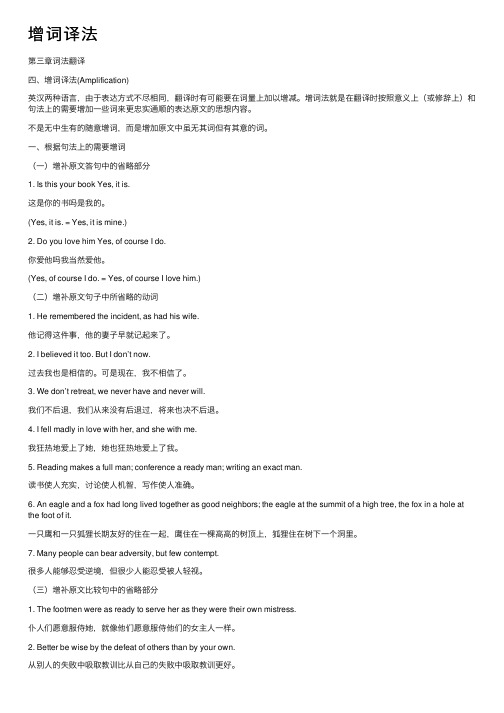
增词译法第三章词法翻译四、增词译法(Amplification)英汉两种语⾔,由于表达⽅式不尽相同,翻译时有可能要在词量上加以增减。
增词法就是在翻译时按照意义上(或修辞上)和句法上的需要增加⼀些词来更忠实通顺的表达原⽂的思想内容。
不是⽆中⽣有的随意增词,⽽是增加原⽂中虽⽆其词但有其意的词。
⼀、根据句法上的需要增词(⼀)增补原⽂答句中的省略部分1. Is this your book Yes, it is.这是你的书吗是我的。
(Yes, it is. = Yes, it is mine.)2. Do you love him Yes, of course I do.你爱他吗我当然爱他。
(Yes, of course I do. = Yes, of course I love him.)(⼆)增补原⽂句⼦中所省略的动词1. He remembered the incident, as had his wife.他记得这件事,他的妻⼦早就记起来了。
2. I believed it too. But I don’t now.过去我也是相信的。
可是现在,我不相信了。
3. We don’t retreat, we never have and never will.我们不后退,我们从来没有后退过,将来也决不后退。
4. I fell madly in love with her, and she with me.我狂热地爱上了她,她也狂热地爱上了我。
5. Reading makes a full man; conference a ready man; writing an exact man.读书使⼈充实,讨论使⼈机智,写作使⼈准确。
6. An eagle and a fox had long lived together as good neighbors; the eagle at the summit of a high tree, the fox in a hole at the foot of it.⼀只鹰和⼀只狐狸长期友好的住在⼀起,鹰住在⼀棵⾼⾼的树顶上,狐狸住在树下⼀个洞⾥。
《写作学教程(第三版)》第三章写作文本

老舍:《四世同堂》
天空中两颗最辉煌的星星要出门,就请她的眼来代替他们闪耀,候着他 们回来。真的,如果她的一双眼睛悬在天空,星星就会代替她的眼睛, 那会怎样?那她脸上的明媚一定盖过星星的亮,如同白日的光压倒了灯光, 在天上她的眼一定照耀满天的光明,鸟儿乱叫,以为白昼已经降临。
文本的内部结构又称布局谋篇,指文章内容的安排。即在 主题的统率下,沿着思路的轨迹,按照一定的顺序把各部 分材料安排好,构成一篇层次清楚、详略分明、首尾连贯、 中心突出的文章。
一、文本结构的要求
文章要做到“三有”:言之有理、言之有物、言 之有序。
言之有理解决的是“为什么写”的问题,也就是 确立什么样的主题,为什么目的而写;
即纵式结构。这是叙述时最常用的结构形 式。
(2)按照空间的变换安排层次,即横式 结构。
(3)以时间为“经”,以空间为“纬”, 采用时空交错的办法来安排层次。
(4)以认识和感情的发展变化为顺序来 安排层次。
2.议论性结构 议论文划分层次的方法,常见的有以下几种:
(1)“三段”式 (2)“花瓣”式 (3)“连环”式 (4)“蛛网”式
我们的倾向性不必明确说明,而是用细节、用语言自然而 然地流露出来的,让读者在文字里看出你的倾向性。
第二节 文本的内在结构
文本是话语活动的产物,话语是指人与人之间在特定语 境中通过文本而进行的交流活动,话语活动的效果和文本 系统内部的结构布局有着非常密切的关系,不同的结构创 造不同的语境,产生不同的效果。
第三章 写作文本
第一节 文本的语言建构
一、 文本语言的中介作用
语言的中介作用首先体现在是它把写作活动中的诸多要素 黏合在一起,构成一个相互作用的整体。
增词译法
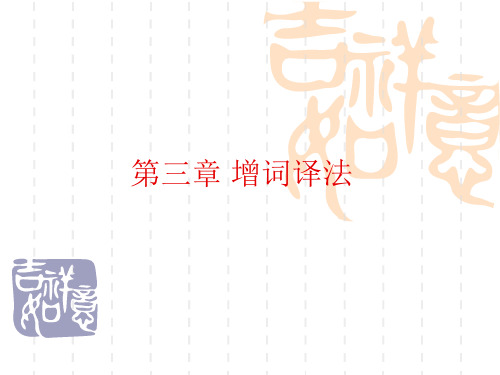
3. 增加表示时态的词语 英语动词的时态是靠动词词型变化和加助动词来表达 的。汉语动词没有时态变化,表达时态时除用具体表 示时间的词或词组,如昨天、此时此刻、下周、20 年前等,还要借助于时态助词“曾、已经、过、了/ 正在、着、/将、就、要、会、便”被用来表示过去 /现在/将来发生的动作或存在的状态。 I had heard about him before I met him. 我在见到他之前就听说过他了。 I was and remain grateful for the part he played in my release. 我获释多亏他帮忙,对此我过去很感激,现在仍然很 感激。 He used to be as poor as we are. 他过去也跟我们现在一样穷。
2)英语中的不及物动词,翻译成汉语时有时在动词后添 加名词 Be sure to wash before meal. 饭前一定要洗手。 Doesn’t she wash after getting up? 起床后她难道不洗漱(洗脸刷牙)吗? Day after day she does the same: washing, sweeping, and cooking. 她日复一日地做着同样的家务:洗衣服,拖地板,做饭。 3)形容词前添加名词 The radio is indeed cheap and fine. 这台收音机真是物美价廉。 She is a complicated girl – moody, sensitive and skeptical. 她是个性格复杂的人:喜怒无常,多愁善感,疑神疑鬼。
我今天上午的确很忙,要上两节课,开一个会, 还要接受一个采访。
He dismissed the meeting without a closing speech. 他没有致闭幕词就宣布结束会议。 The success of the experiment declared a new era of medicine. 实验所取得的成功宣告了一个崭新的医学 时代的到来。
翻译方法之增词法

(3)为了增加背景知识和 文化知识而增词
1)This great scientist was born in New England
这位伟大的科学家出生在 美国东但“新英格兰”则不在英国本土上, 它是美国东北部的一个地区, 包括缅甸、佛蒙特、新罕布什尔、 马萨诸塞、罗得岛、康涅狄格 等六个州。
不同的国家使用不同的经济 资源;不同的人拥有不同的
技能。
⒉ 减词法 从一定的意义上来讲,增词 译法的规律反过来就是减词译法 的规律。
这台电视机真是价廉物美。 If I had known it, I would not have joined in.
同一个世界,同一个梦想。
This television set is cheap and fine.
⑵为了表达清晰和自然而增词
Sino-British links have multiplied—political, commercial, educational, cultural, defence, science and technology.
中英两国在政治、商务、文化、 国防和科技等方面的联系成倍的 增加了。
翻译时无法一个萝卜一个坑, 将原文中每一个词转换成译文 中另一个词,而应该有所增减, 即有时需要在译文中增加一些 原文字面上没有的词语,有时 则要将原文
需要而译文显得多余的词省去 不译,前者称为增词法,后者 称为减词法。不管增词还是减 词,目的都是为了是译文变得 通顺流畅,符合译入语的使用 习惯。
采用增词法应特别注意: 增词不增意,所增之词,其意 义虽然在原文字面上没有清楚 的表现出来,但却隐藏在原文 中,因此,增词法并未违背忠 实的原则。
同样,减词也不能减掉原文的 内容,所减之词,其内涵虽然 在译文字面上没有体现出来, 却隐藏在译文中,因此,减词 法并未违背忠实的原则。
翻译增词法(amplification)
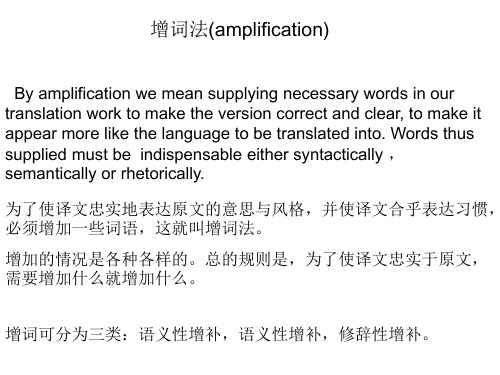
语义性增补(semantic amplification)
为了使语义明确,畅达通顺,符合汉语的习惯,翻译中常常根 据意义的需要增加动词、名词、形容词、副词、量词、范畴词、 概括词,以及表示名词的负数、动词时态等方面的词。
1.Mary washed for a living after her husband died of acute pneumonia.
码丽在丈夫患急性肺炎去世后,靠给人洗衣服维持生活。
2。When I came to I was in the water, swimming automatically, though I was about two thirds drowned.
当我醒来时,发觉自己在水里,虽然浸得半死,却本能地 浮着。
毫无疑问,他以为会有热烈的拥抱,满桌的食物,激动的泪水, 欢乐的笑声,一段接一段的谈话,一次又一次的拥抱,没完没 了。(增加了三个形容词,形象描绘了他想象中的欢乐场景, 使表达更加生动)
2。The sky is clear blue now the sun has flung diamonds down on meadow and bank and wood. 此时已是万里蓝天,太阳把颗颗光彩夺目的钻石洒向草原,洒 向河岸,洒向树林。(增补形容词)
英语中常用省略句,翻译时要根据汉语的表达习惯,作些适当的增 补。
Any person not putting litter in this basket will be liable to a fine of $ 5. 任何不把凌乱的东西放入这个筐内而任意乱扔的人将被处以五美圆 罚款。(增补any person后省略的leaving litter about instead of这一部分。)
增词法

二、语义性增词
• 2.副词/状语
• 中国共产党第十八次全国代表大会,是在我国进入全面建成小康社会 决定性阶段召开的一次十分重要的大会。(P1.Para1)
(小康:中国广大群众所享有的介于温饱与富裕之间的比较殷实的生活状态)
• The Eighteenth National Congress is one of the great importance being held when China has entered the desicive stage of completing the building of a moderately properous society in all respects.
moderately:in a way which is not extreme or stays within reasonable limits
二、语义性增词
• 3.形容词
我们战胜突如其来的非典病情.(P7.Para3.Line5)
(突如பைடு நூலகம்来:事情出乎意料的发生。)
We overcame the unexpected outbreak of the severe acute respiratory syndrome(SARS).
二、语义性增词
• 4.语法需要
全球合作向多层次全方位拓展。Point 11.Para1
Global cooperation is expanding at multiple levels and on all fronts.
二、语义性增词
• 5.概括性词语
①全党一定要勇于实践,勇于变革,勇于创新,②把握时代发展要求, 顺应人民共同愿望,不懈探索和把握中国特色社会主义规律,③永葆党 的生机活力,永葆国家发展动力,在党和人民创造性实践中奋力开拓中 国特色社会主义更为广阔的发展前景。(P12.Para1.Line2) ①The whole Party must boldly engage in practice and make changes and innovations. ②We must respond to the call of the times, follow the aspirations of the people and explore and master the laws of socialism with Chinese characteristics.③We must ensure that the Party is always full of vigor and that China always has the driving force for development.By doing so, (Conclusion)we will open up a bright future for developing socialism with Chinese characteristics through the creative practices of the Party and the people.
增词译法
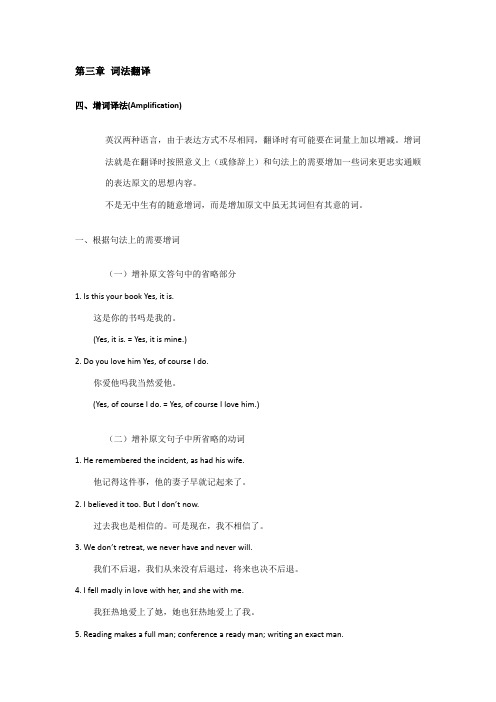
第三章词法翻译四、增词译法(Amplification)英汉两种语言,由于表达方式不尽相同,翻译时有可能要在词量上加以增减。
增词法就是在翻译时按照意义上(或修辞上)和句法上的需要增加一些词来更忠实通顺的表达原文的思想内容。
不是无中生有的随意增词,而是增加原文中虽无其词但有其意的词。
一、根据句法上的需要增词(一)增补原文答句中的省略部分1. Is this your book Yes, it is.这是你的书吗是我的。
(Yes, it is. = Yes, it is mine.)2. Do you love him Yes, of course I do.你爱他吗我当然爱他。
(Yes, of course I do. = Yes, of course I love him.)(二)增补原文句子中所省略的动词1. He remembered the incident, as had his wife.他记得这件事,他的妻子早就记起来了。
2. I believed it too. But I don’t now.过去我也是相信的。
可是现在,我不相信了。
3. We don’t retreat, we never have and never will.我们不后退,我们从来没有后退过,将来也决不后退。
4. I fell madly in love with her, and she with me.我狂热地爱上了她,她也狂热地爱上了我。
5. Reading makes a full man; conference a ready man; writing an exact man.读书使人充实,讨论使人机智,写作使人准确。
6. An eagle and a fox had long lived together as good neighbors; the eagle at the summit of a high tree, the fox in a hole at the foot of it.一只鹰和一只狐狸长期友好的住在一起,鹰住在一棵高高的树顶上,狐狸住在树下一个洞里。
增词法(删减版)

• 增词技巧的运用要注意两个问题:首先要考虑增 词的前提是什么,其次要掌握增词的分寸,即“ 适度性”。 • 增词的前提:是一个动因问题,即是什么原因让 译者采用增词技巧。 • 增词的“适度性”:主要是指译者的自律性,以 防止出现添枝加叶、任意发挥的翻译倾向。 • 根据不同的原理可将増词法分为语义性増词、阐 释性増词、结构性増词和修辞性増词四大类。
地点成分 方式成分
事件一:walk 事件二:he thick carpet killed the sound
行为与结果关系
我走在厚厚的地毯上,一点脚步声也没有。
• After the basketball match, the chairman still has an important meeting. A. 篮球赛之后,主席还要参加一个重要会议。 B. 观看了篮球比赛后,主席还要参加一个重要会议。
以上例句说明了以下三个问题: a.隐性表述必须依托于显性表述而存在,显性表述是推导隐性 表述的依据; b.显性表述和隐性表述之间必定存在某种联系,这种联系是传 输意义的通道,不能识别这种联系就难以推导出话语的言外 之意; c.化隐为显只是调整隐-显表达形式的一种手段,一种语言内 部的化隐为显行为叫做阐释(paraphrase),而语符转换过 程中的化隐为显行为叫做增词译法,通过增词改变了传输信 息的手段,但不改变内容。
• This type of drinker could be a man or a woman. They tend to be sociable and convivial and “like a laugh”. They take short swigs from bottled drinks so they don’t miss out on chipping in with the conversation. The bottle is held loosely at its shoulder for ease. 这类饮酒者男女都有可能。他们爱社交,喜欢热闹,“看上 去总是很开心”。他们持酒瓶喝酒,每喝一口速度都很快, 因为他们不想耽误聊天。[这类人]握瓶颈的姿势很放松。
增词法3
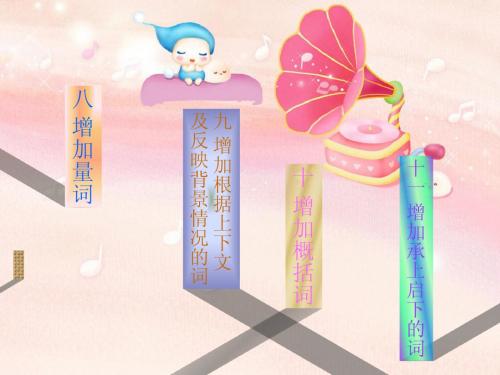
英语和汉语都有概括词。英语中的in short, and so on, etc.等等,翻译时可以分别译为 “总之”、“等等”……。当有时候英语句子中并 没有概括词,而翻译时却往往可增加“两人”、 “双方”、“等等”、“凡此种种”等等概括词, 同时省略掉英语中的连接词。 The Soviet Union, the United States, England and France 苏、美、英、法四国 militarily, politically and economically 军事、政治、经济等各方面
The Americans and the Japanese conducted a completely secret exchange of messages.
美日双方在完全保密的情况下互相交换了信件。
The thesis summed up the new achievements made in electronic computers, artificial satellites and rockets.
A red sun rose slowly from the calm lake。
一轮红日从风平浪静的海面冉冉升起。
8.2 英语中有些动词或动作名词,译成汉 语动词时常 需增加一些表示行为、动作 量的动量词。 1)Once, they have a quarrel。 有一次,他们争吵了一番。 2)Herb gave her a sly look。 赫伯狡猾地看了他一眼。
Three cobblers with their wits combined equeal Zhuge Liang the master mind.
In April,there was the “ping”heard aroun the world. In July, the ping “ponged”。
英汉翻译法6——增词法
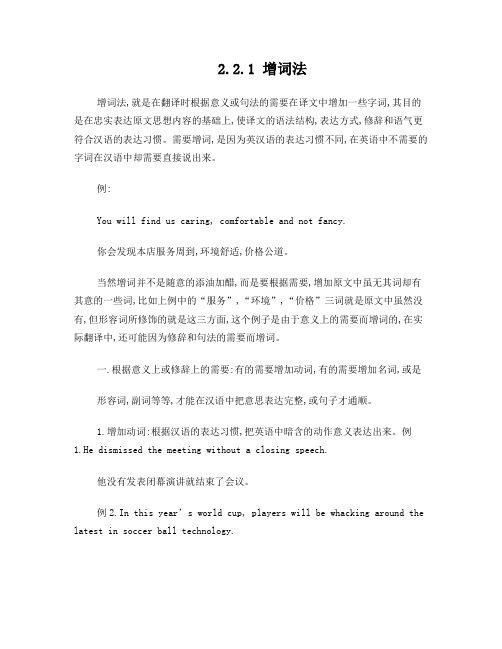
2.2.1 增词法增词法,就是在翻译时根据意义或句法的需要在译文中增加一些字词,其目的是在忠实表达原文思想内容的基础上,使译文的语法结构,表达方式,修辞和语气更符合汉语的表达习惯。
需要增词,是因为英汉语的表达习惯不同,在英语中不需要的字词在汉语中却需要直接说出来。
例:You will find us caring, comfortable and not fancy.你会发现本店服务周到,环境舒适,价格公道。
当然增词并不是随意的添油加醋,而是要根据需要,增加原文中虽无其词却有其意的一些词,比如上例中的“服务”,“环境”,“价格”三词就是原文中虽然没有,但形容词所修饰的就是这三方面,这个例子是由于意义上的需要而增词的,在实际翻译中,还可能因为修辞和句法的需要而增词。
一.根据意义上或修辞上的需要:有的需要增加动词,有的需要增加名词,或是形容词,副词等等,才能在汉语中把意思表达完整,或句子才通顺。
1.增加动词:根据汉语的表达习惯,把英语中暗含的动作意义表达出来。
例1.He dismissed the meeting without a closing speech.他没有发表闭幕演讲就结束了会议。
例2.In this year’s world cup, players will be whacking around the latest in soccer ball technology.在今年的世界杯足球赛上,球员们将会踢一种用最新技术制造的足球。
例3.There were no speeches, no foreign diplomats, no “ordinary Chinese”with paper flags and bouquets of flowers.没有发表讲话,没有各国外交官到场,也没有“普通中国人”挥舞纸旗、花束的场面。
还有一些常增补的动词,如“产生、使、进行、发生、引起”等2.增加形容词:原文中只用名词表达的意义在汉语中需要形容词加名词才能表达完整。
2021年4月自考现代汉语串讲资料:第三章 词汇(3)
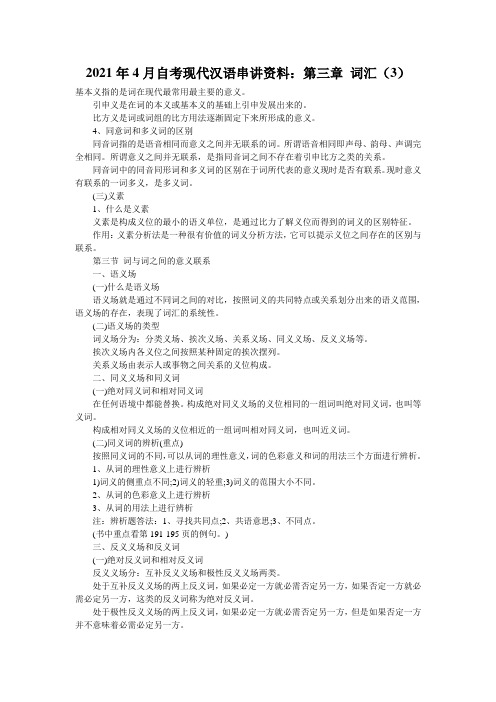
2021年4月自考现代汉语串讲资料:第三章词汇(3)基本义指的是词在现代最常用最主要的意义。
引申义是在词的本义或基本义的基础上引申发展出来的。
比方义是词或词组的比方用法逐渐固定下来所形成的意义。
4、同意词和多义词的区别同音词指的是语音相同而意义之间并无联系的词。
所谓语音相同即声母、韵母、声调完全相同。
所谓意义之间并无联系,是指同音词之间不存在着引申比方之类的关系。
同音词中的同音同形词和多义词的区别在于词所代表的意义现时是否有联系。
现时意义有联系的一词多义,是多义词。
(三)义素1、什么是义素义素是构成义位的最小的语义单位,是通过比力了解义位而得到的词义的区别特征。
作用:义素分析法是一种很有价值的词义分析方法,它可以提示义位之间存在的区别与联系。
第三节词与词之间的意义联系一、语义场(一)什么是语义场语义场就是通过不同词之间的对比,按照词义的共同特点或关系划分出来的语义范围,语义场的存在,表现了词汇的系统性。
(二)语义场的类型词义场分为:分类义场、挨次义场、关系义场、同义义场、反义义场等。
挨次义场内各义位之间按照某种固定的挨次摆列。
关系义场由表示人或事物之间关系的义位构成。
二、同义义场和同义词(一)绝对同义词和相对同义词在任何语境中都能替换。
构成绝对同义义场的义位相同的一组词叫绝对同义词,也叫等义词。
构成相对同义义场的义位相近的一组词叫相对同义词,也叫近义词。
(二)同义词的辨析(重点)按照同义词的不同,可以从词的理性意义,词的色彩意义和词的用法三个方面进行辨析。
1、从词的理性意义上进行辨析1)词义的侧重点不同;2)词义的轻重;3)词义的范围大小不同。
2、从词的色彩意义上进行辨析3、从词的用法上进行辨析注:辨析题答法:1、寻找共同点;2、共语意思;3、不同点。
(书中重点看第191-195页的例句。
)三、反义义场和反义词(一)绝对反义词和相对反义词反义义场分:互补反义义场和极性反义义场两类。
处于互补反义义场的两上反义词,如果必定一方就必需否定另一方,如果否定一方就必需必定另一方,这类的反义词称为绝对反义词。
- 1、下载文档前请自行甄别文档内容的完整性,平台不提供额外的编辑、内容补充、找答案等附加服务。
- 2、"仅部分预览"的文档,不可在线预览部分如存在完整性等问题,可反馈申请退款(可完整预览的文档不适用该条件!)。
- 3、如文档侵犯您的权益,请联系客服反馈,我们会尽快为您处理(人工客服工作时间:9:00-18:30)。
2. They won victories in the past years.
在过去的两年里,我们取得了一次又一次的 胜利。
Company Logo
Logo
3. The very earth trembled as with the tramps of horses and murmur of angry men.
她们有的长着漂亮的眼睛,有的生着俏丽 的鼻子,有的有着妩媚的嘴巴、婀娜的身 段;但是,这样样都美的,虽然不能说一 个没有,却也是寥寥无几。
Company Logo
Logo
6.I
fell madly in love with her, and
she with me.
conference a ready man; writing an exact man.
读书使人充实,讨论使人机智,写作
使人准确。
Company Logo
Logo
4.
Such is war: to the victor, the
spoils; to the defeated, the costs.
一种新型的飞机正越来越引起人们的注 意——它体积小,价格低,无人驾驶。
(P68(五))
Company Logo
Logo
3.增补表示复数的词(P62)
1.There were rows of houses which he had never seen before. 一排排的房子,都是他从来没有见过的。
Company Logo
Logo
翻译下列的句子
1. “How shall I do it?”---- “ Just as you wish.” 2. They would not have done such a thing without government approval. 3.Now and then his boots shone. 4.She is sitting in a BMW. 5.From the evaporation of water people know that liquids can turn into gases under certain conditons.
Company Logo
Logo
2.
Note that the words “ foxy”, “mean” and “ generous” require explanation. “慷慨的”这三个词需要解释一下。
请注意:“狡猾的”、“吝啬的”和
Company Logo
Logo
A thousand years will pass and the guilt of Germany will not be erased. ---- Hansal of Poland
Company Logo
Logo
3.
Divorce is increasing in this
country with growing urbanization.
随着城镇化进程的推进,这个国家的
离婚率逐步攀升。
Company Logo
Logo
1. necessity 2. jealousy 3. transformation 4. irregularities 5. fault-finding 6. readability 7. madness 8. segregation 9. observation 10.arrogance P74(四)
3.读书足以怡情,足以博采,足以长才。(王佐 良)
Company Logo
Logo
(一)结构性增补
Structural addition is mainly due to the structural or grammatical differences between English and Chinese. What is omitted or unnecessary in English may be indispensable in Chinese, or vice versa; hence the principle of addition in translating.
如果不懂得制图或看不懂图纸,就不能造 船、盖房子或制造机床。
Company Logo
Logo
2.
He was a quiet and thoughtful man.
他举止文雅,待人体贴。
Company Logo
Logo
1. This is the best solution to your problem. 这是你那个问题最好的解决方案。
2. At the same time, inequality has become worse. 同时,不平等现象变得更严重了。
千年易逝, 德国的罪孽难消。 ——驻波兰总督汉斯•弗朗克
Company Logo
Logo
二、语义和修辞性增补
Company Logo
Logo
1.不及物动词增补宾语(P60)
1. He never drinks before driving. 他开车前从不喝酒。 2. Before liberation, his mother lived on washing. 解放前,他妈妈靠洗衣为生。
Logo
7.增加表达时态的词(P63)
(过去)完成时:曾、已经、过、了; 进行时:在、正在、着
将来时:将、就、会、要、便
P68(七)
Company Logo
Logo
8.增补语气助词(P64)
1. Don’t take it seriously. I’m just making fun of you.
Company Logo
Logo
5. 增补范畴词(P61)
由动词或形容词加后缀-tion, -ness等派 生出来的名词, 如:
backwardness:落后面貌/落后状态 preparation:准备工作
sadness: 悲观主义
Company Logo
不要认真嘛!我不过开开玩笑罢了。
Company Logo
Logo
2. As for me, I didn’t agree from the very beginning.
我呢,从一开始就不赞成。
(P69(九))
我狂热地爱上了她,她也狂热地爱上
了我。
Company Logo
Logo
2. 补充译文结构或搭配所需要的词语
1.You cannot build a ship, a house, or a machine tool if you do not know how to make or read a design.
农民“啪”地一声折断了一根树枝,把它放 进火里。
Company Logo
Logo
3.
Into the dim clouds was swimming a crescent moon. 一钩新月渐渐隐没在朦胧的云彩里去了。
P69(八)
Logo
3. 增补潜在词
1. I began the book yesterday.
昨天我开始读(写)这本书。
2.The new American Secretary of State has proposed a world conference on food supplies. 美国新任国务卿建议召开世界食品资源问 题会议。
Company Logo
Logo
2.在形容词前增加名词(P61)
1.
this typewriter is indeed cheap and fine.
这部打字机真是价廉物美。
Company Logo
Logo
2. A new kind of aircraft—small, cheap, pilotless —is attracting increasing attention.
Company Logo
Logo
3. The United States, China, England, France and Japan are now cooperation.
美、中、英、法、日五国正在合作。
(P72(五))
Company Logo
Logo
第三节 增词法 Addition
Logo
英汉两种语言,由于表达方式不同,翻
译时不仅可以将词类转译,又可以在词 量上进行增减。
Company Logo
Logo
按照英语的表达方式,有些词是有其意而 无其形的,这种情况在译成汉语时就要增 补一些词语,使之符合汉语的表达方式, 从而更加通顺地表达原文的思想内容。
连大地都震动了,仿佛万马奔腾,千夫
怒吼。
(P69(八))
Company Logo
Logo
4.增补修饰性和解释性词语
1. Blood and Sand (电影名) 《碧血黄沙》/《血与沙》
2. The farmer snapped a stick and put it into the fire.
